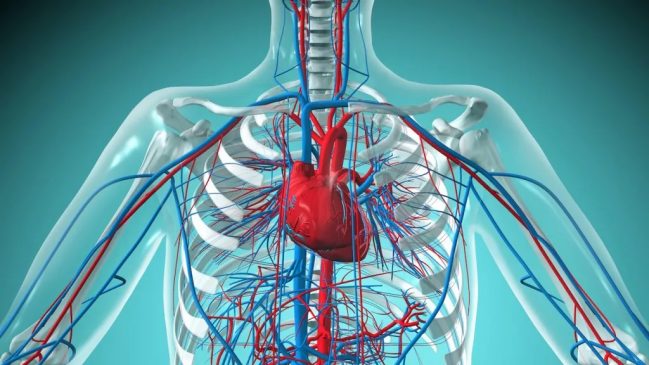The human heart is an organ that pumps blood throughout the body via the circulatory system.

The human heart is an organ that pumps blood throughout the body via the vessels of the circulatory system, supplying oxygen and nutrients to the tissues and removing carbon dioxide and other wastes.
“The tissues of the body need a constant supply of nutrition in order to be active,” said Dr. Lawrence Phillips, a cardiologist at NYU Langone Medical Center in New York. “If [the heart] is not able to supply blood to the organs and tissues, they’ll die.”
The human heart is located in the center of the chest – slightly to the left of the sternum (breastbone). It sits between your lungs and is encased in a double-walled sac called the pericardium, according to the Texas Heart Institute. The pericardium serves to protect the heart and anchor it inside the chest. Pericardial fluid acts as a lubricant between the outer layer, the parietal pericardium, and the inner layer, the serous pericardium. The fluid lubricates the heart during contractions and movements of the lungs and diaphragm.
In humans, the heart is roughly the size of a large fist and weighs between about 10 and 12 ounces (280 and 340 grams) in men, and between 8 and 10 ounces (230 and 280 grams) in women, according to Henry Gray’s “Anatomy of the Human Body.”
The physiology of the heart basically comes down to “structure, electricity and plumbing,” Phillips told Live Science.
The human heart has four chambers: two upper chambers (the atria) and two lower ones (the ventricles), according to the National Institutes of Health. The right atrium and right ventricle together make up the “right heart,” and the left atrium and left ventricle make up the “left heart.” A wall of muscle called the septum separates the two sides of the heart.
The heart’s outer wall consists of three layers. The outermost wall layer, or epicardium, forms the inner wall of the pericardium. The middle layer, or myocardium, contains the muscle that contracts the heart. The inner layer, or endocardium, lines the heart chambers, according to the British Heart Foundation.
Connecting the upper and lower chambers of the heart are the atrioventricular (AV) valves — made up of the tricuspid valve and the mitral valve. The pulmonary semi-lunar valve separates the right ventricle from the pulmonary artery, and the aortic valve separates the left ventricle from the aorta. The heartstrings, or chordae tendinae, anchor the valves to heart muscles.
The heart circulates blood through two pathways: the pulmonary circuit and the systemic circuit.
In the pulmonary circuit, deoxygenated blood leaves the right ventricle of the heart via the pulmonary artery and travels to the lungs; then the oxygenated blood returns through the pulmonary vein to the left atrium of the heart, according to the journal Biomedical Sciences.
In the systemic circuit, oxygenated blood leaves the heart and travels through the left ventricle to the aorta, and from there enters the arteries and capillaries where it supplies the body’s tissues with oxygen. Deoxygenated blood returns through veins to the venae cavae, re-entering the heart’s right atrium.
Of course, the heart is also a muscle, so it needs a fresh supply of oxygen and nutrients, too, Phillips said.
“After the blood leaves the heart through the aortic valve, two sets of arteries bring oxygenated blood to feed the heart muscle,” he said. The left main coronary artery, on one side of the aorta, branches into the left anterior descending artery and the left circumflex artery. The right coronary artery branches out on the right side of the aorta.
Blockage of any of these arteries can cause a heart attack, or damage to the heart muscle, Phillips said. A heart attack is distinct from cardiac arrest, which is a sudden loss of heart function that usually occurs as a result of electrical disturbances of the heart rhythm. A heart attack can lead to cardiac arrest, but the latter can also be caused by other problems, he said.
The heart contains electrical “pacemaker” cells, which cause it to contract — producing a heartbeat.
“Each cell has the ability to be the ‘band leader’ and [to] have everyone follow,” Phillips said. In people with an irregular heartbeat, or atrial fibrillation, every cell tries to be the band leader, he said, which causes them to beat out of sync with one another.
A healthy heart contraction happens in five stages. In the first stage (early diastole), the heart is relaxed. Then the atrium contracts (atrial systole) to push blood into the ventricle. Next, the ventricles start contracting without changing volume. Then the ventricles continue contracting while empty. Finally, the ventricles stop contracting and relax. Then the cycle repeats. Valves prevent backflow, keeping the blood flowing in one direction through the heart.
By the end of the day, your heart will have beaten around 100,000 times (around 60 to 80 beats per minute). This will pump around 1.5 gallons (around 6.8 liters) of blood per minute through the 60,000 miles (around 97,000 kilometers) of blood vessels that are in the human body, according to the Cleveland Clinic.
